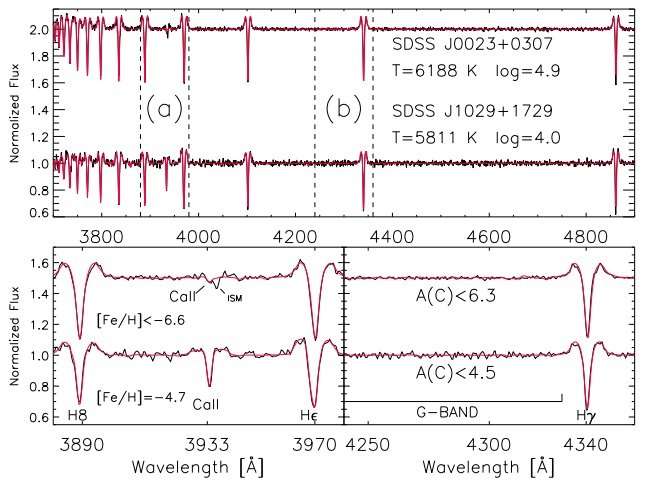February 27, 2018 report
Astronomers identify a mega metal-poor dwarf star

A group of Spanish astronomers has found a new primitive mega metal-poor star. The object, designated SDSS J0023+0307, is apparently one of the most iron-poor stars known to date. The finding is reported February 17 in a paper published on the arXiv pre-print repository.
Metal-poor stars are rare objects as only few stars with iron abundances [Fe/H] below –5 have been discovered so far. Currently, SMSS J0313–6708, with metallicity below –7.1, is the most iron-poor star known to date. Astronomers are interested in expanding the still short list of metal-poor stars as such objects have the potential to improve our knowledge of the chemical evolution of the universe.
During recent years, a team of astronomers led by David S. Aguado of the Institute of Astrophysics in the Canary Islands, has been searching for extremely metal-poor stars by analyzing low-resolution spectroscopic data provided by various instruments. This search has already resulted in finding a carbon-enhanced metal-poor red giant with iron abundance of -4.7 and a dwarf star with iron abundance below –5.8.
Now, Aguado's team found an extremely metal-poor candidate in the SDSS/BOSS spectroscopic survey. Next, they conducted follow-up observations of this candidate using the Intermediate dispersion Spectrograph and Imaging System (ISIS) on the 4.2m William Herschel Telescope (WHT) and the Optical System for Imaging and low-intermediate-Resolution Integrated Spectroscopy (OSIRIS) at the Gran Telescopio Canarias (GTC).
"We have now identified a new mega metal-poor dwarf with [Fe/H]< −6.6, J0023+0307, from SDSS/BOSS spectra (λ/∆λ ~2, 000). Follow-up spectroscopy with the 10.4m GTC and the 4.2m WHT telescopes confirms the metallicity determination based on SDSS data," the researchers wrote in the paper.
As noted in the study, the newly detected metal-poor star, named SDSS J0023+0307, has an iron abundance below –6.6. Moreover, the astronomers found that this star has a carbon abundance below 6.3 and an effective temperature of 6,188 K.
Although the scientists were only able to set upper limits for the iron and carbon abundances of SDSS J0023+0307, the results indicate that this object is one of the two most iron-poor stars known, and exhibits less carbon that most of stars with iron abundances below –5.
"The spectrum of this star does not show the usual enhancement in carbon found in all other stars at [Fe/H]< −5," the paper reads.
The authors of the paper noted that given that the iron abundance is only an upper limit, and since carbon does not appear enhanced at the levels found in other hyper metal-poor stars, J0023+0307 could well be the most metal-poor star so far identified. However, more observations at higher resolution and signal-to-noise ratio are required to validate this assumption.
"Newer observations with higher spectral resolution and very high signal-to-noise ratio are required and can only be obtained with the largest telescopes in the world," the researchers concluded.
More information: J0023+0307: A MEGA METAL-POOR DWARF STAR FROM SDSS/BOSS, arxiv.org/pdf/1802.06240.pdf
© 2018 Phys.org




















